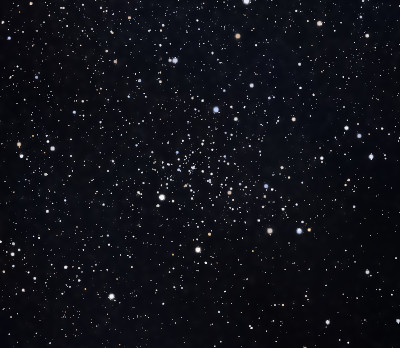
10x50 binoculars (9/9/83):very bright, very large, consists of mag 7 and fainter stars. Includes many chains and knots over a one degree field! Larger but not as conspicuous as nearby NGC 6633 in Ophiuchus. Easy naked-eye cluster in dark sky.
Solon Bailey found IC 4756 in 1896 on a plate taken with a 1" Cooke lens at the Arequipa station in Peru (Annals of Harvard College Observatory, Vol LX, No VIII, 1908) and is credited with the discovery in the IC2. But it was discovered visually by Reverend Thomas Webb by 1859 with his 3.7" Tully refractor. In the listing for NGC 6633 in his "Celestial Objects for Common Telescopes" (1859) Webb wrote, "Between it NGC 6633] and Theta, nearer the former, is a beautiful large cloud of stars, chiefly 8 or 9 mag., a nearer part, apparently, of the Galaxy: visible to the naked-eye, and requiring a large field." The nickname "Graff's Cluster" comes from German astronomer Kasimir Graff, who independently discovered it in 1922.
400/500mm - 17.5" (7/26/95): overfills 50' field with 20 Nagler. Contains roughly 70 stars brighter than mag 11 and too many faint stars to count. There are two mag 6.5 stars near the northwest and southeast ends of the cluster (the latter star is not physical member) at the edges of the field (46' separation). There are no rich subgroups or central concentration but many stars are arranged in long chains and curving loops. The most prominent is a long chain oriented NW-SE through the center. Visible as a naked-eye patch at the edge of the Milky Way.
Notes by Steve Gottlieb